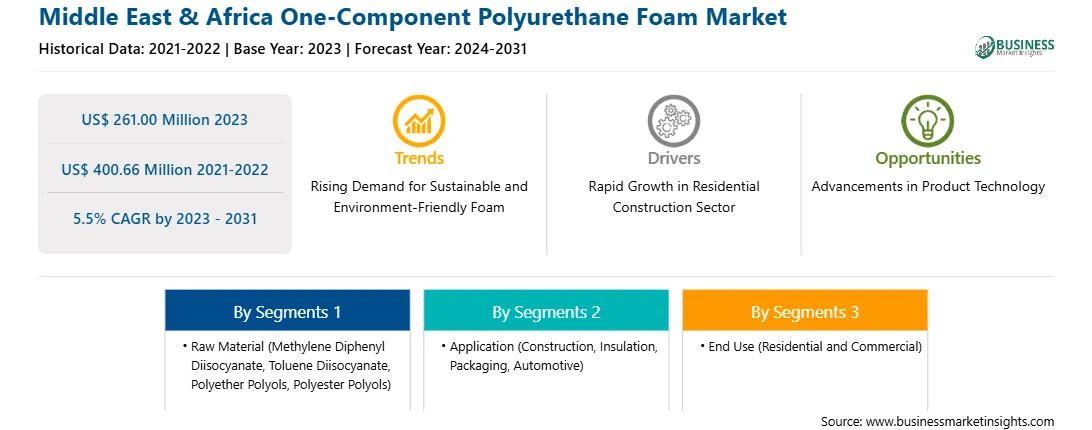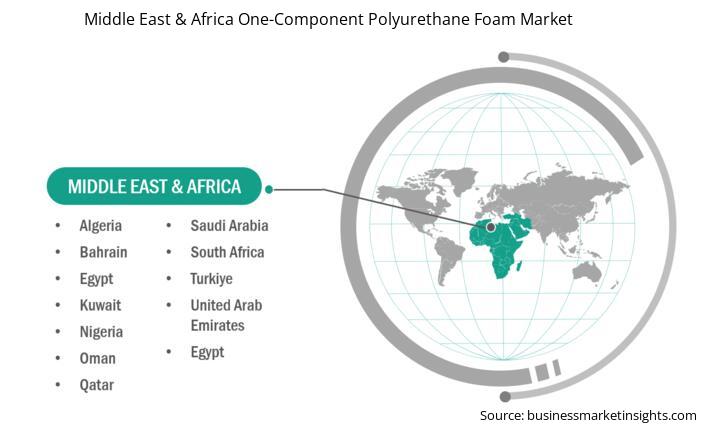The Middle East & Africa one-component polyurethane foam market was valued at US$ 261.00 million in 2023 and is expected to reach US$ 400.66 million by 2031; it is estimated to register a CAGR of 5.5% from 2023 to 2031.
Rising Demand for Sustainable and Environment-Friendly Foam Bolsters Middle East & Africa One-Component Polyurethane Foam Market
One-component polyurethane foam offers several advantages that align with sustainable goals. It is highly energy-efficient, providing superior thermal insulation properties that help reduce the heating and cooling costs of buildings. By improving the energy efficiency of structures, polyurethane foam contributes to lower carbon emissions and reduced reliance on fossil fuels for heating and cooling, thereby supporting environmental sustainability efforts.
Moreover, advancements in polyurethane foam formulations have led to the development of eco-friendly alternatives that use bio-based or recycled materials as feedstocks. These bio-based and recycled polyurethane foams offer comparable performance to traditional petroleum-based foams while reducing reliance on finite fossil fuel resources and mitigating the environmental impact of production. Additionally, these sustainable formulations help address concerns about waste management and contribute to the circular economy by utilizing renewable or recycled materials in foam production. Furthermore, the versatility of one-component polyurethane foam extends its applicability to green building practices and sustainable construction projects. Builders and developers increasingly incorporate polyurethane foam insulation into green building designs to achieve energy-efficient and environmentally friendly buildings that meet green building certifications such as Leadership in Energy and Environmental Design or Building Research Establishment Environmental Assessment Methods. The use of polyurethane foam in green buildings enhances energy efficiency and improves indoor air quality, occupant comfort, and overall building performance while aligning with sustainability objectives. Thus, the rising demand for sustainable and environmentally friendly foam is likely to bring in new trends, which would, in turn, increase the adoption of one-component polyurethane foam across many industries.
Middle East & Africa One-Component Polyurethane Foam Market Overview
Countries such as South Africa, the UAE, and Saudi Arabia in the Middle East & Africa are witnessing a massive demand for one-component polyurethane foam due to the growing demand from residential, industrial, and commercial sectors. The demand for new residential projects has augmented due to a migration surge from rural to urban areas. Further, the rising population is boosting the construction of residential areas. For instance, as per the United Nations Report on Urbanization and Migration in Africa, the urban population of the region has been increasing considerably (i.e., from ~27% in 1950 to 40% in 2015). It is expected to reach 60% by 2050. As more people move to urban areas, there is a parallel surge in construction activities to accommodate the expanding population. One-component polyurethane foam plays a crucial role in this urban development by providing efficient insulation, sealing, and filling solutions for building and infrastructure projects. In addition, in the automotive industry, molded foam is used in components such as seats, armrests & headrests, and door panels. Further, the automotive industry is pivotal in driving demand for one-component polyurethane foam in the Middle East & Africa. The booming automotive market in the Middle East & Africa has increased vehicle production and sales. The expanding automotive industry is projected to surge the demand for lightweight, durable, and versatile materials for various applications within vehicles. polyurethane foam is widely used in automotive interiors for seating, cushioning, and noise insulation. It provides superior comfort for passengers, reduces vibrations, and improves the overall driving experience. According to the Organization of the Petroleum Exporting Countries (OPEC), the Middle East & Africa is projected to have 90 million vehicles on the road by 2040, which is up from 59 million in 2018. As the automakers in the Middle East & Africa strive to meet the evolving customer demands and adhere to regulatory requirements, one-component polyurethane foam is expected to remain a critical material in the production of vehicles that provide both superior driving experience and safety.
Middle East & Africa One-Component Polyurethane Foam Market Revenue and Forecast to 2031 (US$ Million)
Strategic insights for the Middle East & Africa One-Component Polyurethane Foam provides data-driven analysis of the industry landscape, including current trends, key players, and regional nuances. These insights offer actionable recommendations, enabling readers to differentiate themselves from competitors by identifying untapped segments or developing unique value propositions. Leveraging data analytics, these insights help industry players anticipate the market shifts, whether investors, manufacturers, or other stakeholders. A future-oriented perspective is essential, helping stakeholders anticipate market shifts and position themselves for long-term success in this dynamic region. Ultimately, effective strategic insights empower readers to make informed decisions that drive profitability and achieve their business objectives within the market. The geographic scope of the Middle East & Africa One-Component Polyurethane Foam refers to the specific areas in which a business operates and competes. Understanding local distinctions, such as diverse consumer preferences (e.g., demand for specific plug types or battery backup durations), varying economic conditions, and regulatory environments, is crucial for tailoring strategies to specific markets. Businesses can expand their reach by identifying underserved areas or adapting their offerings to meet local demands. A clear market focus allows for more effective resource allocation, targeted marketing campaigns, and better positioning against local competitors, ultimately driving growth in those targeted areas.Middle East & Africa One-Component Polyurethane Foam Strategic Insights

Middle East & Africa One-Component Polyurethane Foam Report Scope
Report Attribute
Details
Market size in 2023
US$ 261.00 Million
Market Size by 2031
US$ 400.66 Million
CAGR (2023 - 2031) 5.5%
Historical Data
2021-2022
Forecast period
2024-2031
Segments Covered
By Raw Material
By Application
By End Use
Regions and Countries Covered
Middle East and Africa
Market leaders and key company profiles
Middle East & Africa One-Component Polyurethane Foam Regional Insights

Middle East & Africa One-Component Polyurethane Foam Market Segmentation
The Middle East & Africa one-component polyurethane foam market is categorized into raw material, application, end use, and country.
Based on raw material, the Middle East & Africa one-component polyurethane foam market is divided into methylene diphenyl diisocyanate, toluene diisocyanate, polyether polyols, polyester polyols, and others. The polyether polyols segment held the largest Middle East & Africa one-component polyurethane foam market share in 2023.
In terms of application, the Middle East & Africa one-component polyurethane foam market is segmented into construction, insulation, packaging, automotive, and others. The construction segment held the largest Middle East & Africa one-component polyurethane foam market share in 2023.
By end use, the Middle East & Africa one-component polyurethane foam market is bifurcated into residential and commercial. The commercial segment held a larger Middle East & Africa one-component polyurethane foam market share in 2023.
By country, the Middle East & Africa one-component polyurethane foam market is segmented into Saudi Arabia, the UAE, South Africa, and the Rest of Middle East & Africa. The Rest of Middle East & Africa dominated the Middle East & Africa one-component polyurethane foam market share in 2023.
Henkel AG & Co KGaA, Sika AG, The Dow Chemical Co, BASF SE, Huntsman Corp, Selena Group, Tremco CPG Inc., and Soudal Group are some of the leading companies operating in the Middle East & Africa one-component polyurethane foam market.
The Middle East & Africa One-Component Polyurethane Foam Market is valued at US$ 261.00 Million in 2023, it is projected to reach US$ 400.66 Million by 2031.
As per our report Middle East & Africa One-Component Polyurethane Foam Market, the market size is valued at US$ 261.00 Million in 2023, projecting it to reach US$ 400.66 Million by 2031. This translates to a CAGR of approximately 5.5% during the forecast period.
The Middle East & Africa One-Component Polyurethane Foam Market report typically cover these key segments-
The historic period, base year, and forecast period can vary slightly depending on the specific market research report. However, for the Middle East & Africa One-Component Polyurethane Foam Market report:
The Middle East & Africa One-Component Polyurethane Foam Market is populated by several key players, each contributing to its growth and innovation. Some of the major players include:
The Middle East & Africa One-Component Polyurethane Foam Market report is valuable for diverse stakeholders, including:
Essentially, anyone involved in or considering involvement in the Middle East & Africa One-Component Polyurethane Foam Market value chain can benefit from the information contained in a comprehensive market report.